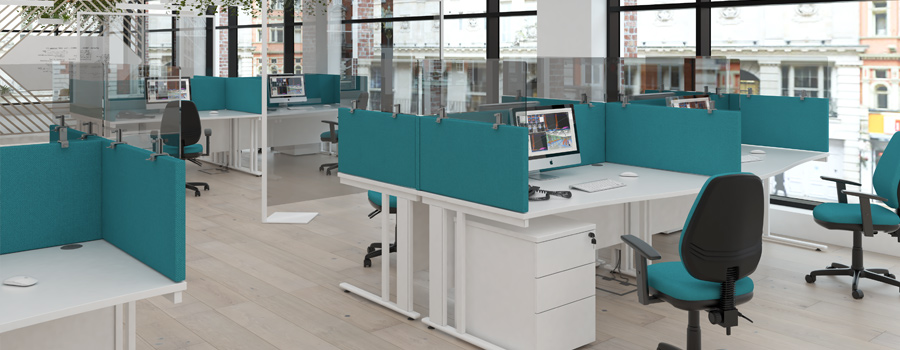The world has, of course, experienced widespread disruption over the past year as a result of the Covid-19 pandemic. With the successful development and distribution of a Covid-19 vaccine, the timeline for when the so-called next normal will arrive is clearer. Companies should begin to take steps to consider what the workplace will look like when it arrives.

There is no going back to the pre-pandemic workplace – businesses and individuals have no choice but to discover new ways of working. In a time of unprecedented change, we have an equally momentous opportunity to shape the future of work.
The wellbeing of employees in the workplace is becoming more vital, and office furniture can play a huge part in helping to keep people happy and healthy when they’re working. There is no single type of optimal work setting to suit everyone. Instead, it’s about balance. Companies that don’t provide workers with the types of spaces they need to manage the demands and intensity of work will find that this can have a negative impact on employee wellbeing.
What employees expect from the officeWhile health and safety were the top motivators for sending employees home to work at the start of the lockdown, health and safety concerns will also impact the return to the office. The future office needs to serve as a hub for productivity, collaboration, socialising, and in-person connectivity. There still needs to be a space for focused work, calls or video meetings, but this can’t override the desire for collaboration or replace the social aspect to the working day.
We may work in new ways and in new spaces but some things never change. We all need connection with other people, comfort and flexibility. Working from home employees will cause office footprints to shrink, so there will be a trade-off between working from home and having a dedicated desk. Businesses will also need to consider the potential for reduced office occupancy, which has ramifications for how much office space they need, and what types of workspaces they offer employees.
Adapting existing spacesBusinesses that flex to their employees changing needs will have the advantage. This means being able to read how workers are settling into the ‘new normal’ and meeting them where they are, sometimes on the fly. The most effective and modern office spaces are characterised by division into different zones that support employees as they perform particular tasks. An office should be adjusted to employees, not the other way round.
Accommodate new ways of working by enhancing your existing products and blending new solutions into the workplace. Biophilic experiences can reduce stress, improve cognitive function, and enhance mood and creativity. Screens and dividers will negate the need to reconfigure existing spaces by applying appropriate distance between people.
If colleagues are too close and workplaces are too densely populated, then people will naturally feel uncomfortable in the space, so high screens can be added to existing furniture to provide a protective barrier, whether on single desks, bench desk clusters, meeting areas or social spaces.
Dams is a Cabinet office approved supplier of compliant products for back to work solutions, with a range of desktop and floor screens designed to make workplace Covid-secure. Acrylic desktop protection screens available from Dams reduce the risk of airborne germs between colleagues whilst still enabling them visibility, and new for 2021 the acrylic fixed desktop screens, free-standing screens and screen toppers are available with new brackets for enhanced stability.
New, defined spacesEmployees will need spaces designed for collaborative meetings, areas for agile working, opportunities to relax, as well as places to escape to focus on individual tasks, and businesses can design physical workplaces to support it. Different office configurations could be employed depending on whether a group is brainstorming, hosting a training session, or conducting a daily meeting.
The workplace has always been more than just a place to work. We create, we innovate, we meet and we eat, and with people making up around 60% of an organisation’s costs, it is vital that today’s workplace created a happy and productive work ‘space’. The right arrangement of people, processes and places will enhance the office aesthetics, improve employee wellbeing, increase cooperation and help facilitate decision-making business processes.
In the long-term, multi-functional spaces will be the reason why people enjoy coming into the office. These are the spaces where people can work according to their own needs and preferences and interact with the people around them to feel part of a community. Designed well, these agile social spaces can help to make the office somewhere people want to be. Businesses need to adapt and re-imagine work environments, and create a flexible design to cater to the new needs of the workforce. Have a browse through Dams’ latest Social Spaces furniture designs for modern office environments, workspaces and commercial interiors to get some inspiration!
Shape the future of workRe-thinking the workplace also opens up new opportunities for re-thinking the workforce and, ultimately, work itself. The workplace and work of the future will be fundamentally different as a result of the pandemic. Leaders must learn to continually re-invent the future of work, and now is the time to begin discovering how to bring that future about. Whatever that looks like, we will work with you to make sure your employees feel safe, healthy, and are comfortable in their place of work.
Let’s start by planning offices around their inherent strengths: bringing people together in physical space and supporting the kind of interaction and productivity not possible when working remote. Most of all, let’s place a premium on safety and flexibility. Workers will thrive when given choice over how and where they can be most effective. We can retro-fit your existing products, re-design your spaces, and help you re-imagine your new normal.